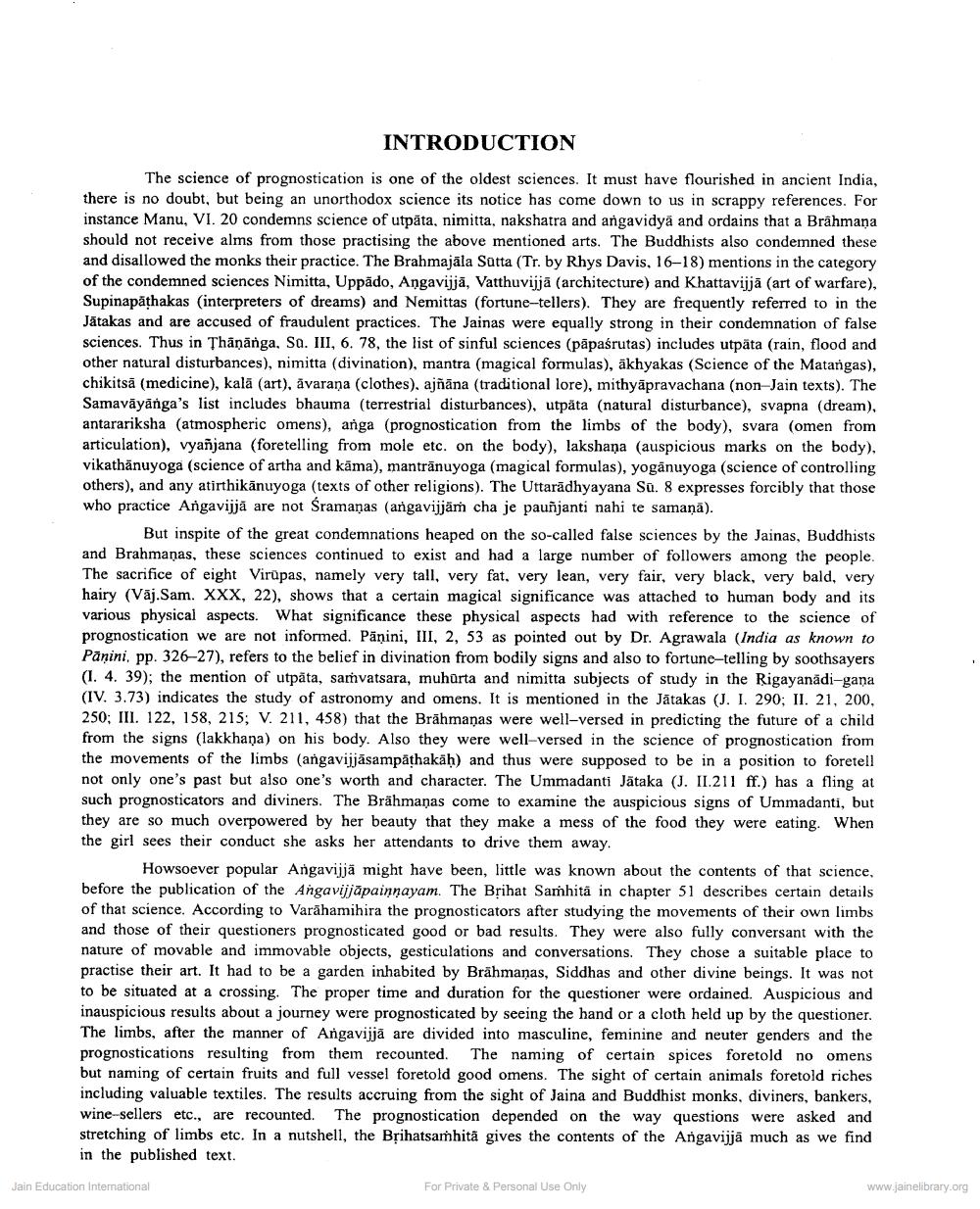________________
INTRODUCTION
The science of prognostication is one of the oldest sciences. It must have flourished in ancient India, there is no doubt, but being an unorthodox science its notice has come down to us in scrappy references. For instance Manu, VI. 20 condemns science of utpāta, nimitta, nakshatra and angavidya and ordains that a Brahmana should not receive alms from those practising the above mentioned arts. The Buddhists also condemned these and disallowed the monks their practice. The Brahmajāla Satta (Tr. by Rhys Davis, 16-18) mentions in the category of the condemned sciences Nimitta, Uppado, Angavijjā, Vatthuvijja (architecture) and Khattavijjā (art of warfare), Supinapāthakas (interpreters of dreams) and Nemittas (fortune-tellers). They are frequently referred to in the Jātakas and are accused of fraudulent practices. The Jainas were equally strong in their condemnation of false sciences. Thus in Thānanga, So. III, 6. 78, the list of sinful sciences (pāpaśrutas) includes utpata (rain, flood and other natural disturbances), nimitta (divination), mantra (magical formulas), ākhyakas (Science of the Matangas), chikitsa (medicine), kală (art), avarana (clothes), ajñāna (traditional lore), mithyāpravachana (non-Jain texts). The Samavāyānga's list includes bhauma (terrestrial disturbances), utpåta (natural disturbance), svapna (dream), antarariksha (atmospheric omens), anga (prognostication from the limbs of the body), svara (omen from articulation), vyañjana (foretelling from mole etc. on the body), lakshana (auspicious marks on the body), vikathānuyoga (science of artha and kāma), mantrānuyoga (magical formulas), yogānuyoga (science of controlling others), and any atirthikānuyoga (texts of other religions). The Uttaradhyayana Sa. 8 expresses forcibly that those who practice Angavijjā are not śramaņas (angavijjām cha je pauñjanti nahi te samaņā).
But inspite of the great condemnations heaped on the so-called false sciences by the Jainas, Buddhists and Brahmanas, these sciences continued to exist and had a large number of followers among the people. The sacrifice of eight Virupas, namely very tall, very fat, very lean, very fair, very black, very bald, very hairy (Vāj.Sam. XXX, 22), shows that a certain magical significance was attached to human body and its various physical aspects. What significance these physical aspects had with reference to the science of prognostication we are not informed. Pänini, III, 2, 53 as pointed out by Dr. Agrawala (India as known to Pāņini. pp. 326-27), refers to the belief in divination from bodily signs and also to fortune-telling by soothsayers (1. 4. 39); the mention of utpåta, samvatsara, muhurta and nimitta subjects of study in the Rigayanādi-gana (IV. 3.73) indicates the study of astronomy and omens. It is mentioned in the Jātakas (J. I. 290; II. 21, 200, 250; III. 122, 158, 215; V. 211, 458) that the Brāhmaṇas were well-versed in predicting the future of a child from the signs (lakkhana) on his body. Also they were well-versed in the science of prognostication from the movements of the limbs (angavijjāsampathakāḥ) and thus were supposed to be in a position to foretell not only one's past but also one's worth and character. The Ummadanti Jätaka (I. II.211 ff.) has a fling at such prognosticators and diviners. The Brāhmaṇas come to examine the auspicious signs of Ummadanti, but they are so much overpowered by her beauty that they make a mess of the food they were eating. When the girl sees their conduct she asks her attendants to drive them away.
Howsoever popular Angavijjä might have been, little was known about the contents of that science, before the publication of the Angavijjāpainnayam. The Brihat Samhita in chapter 51 describes certain details of that science. According to Varāhamihira the prognosticators after studying the movements of their own limbs and those of their questioners prognosticated good or bad results. They were also fully conversant with the nature of movable and immovable objects, gesticulations and conversations. They chose a suitable place to practise their art. It had to be a garden inhabited by Brāhmaṇas, Siddhas and other divine beings. It was not to be situated at a crossing. The proper time and duration for the questioner were ordained. Auspicious and inauspicious results about a journey were prognosticated by seeing the hand or a cloth held up by the questioner. The limbs, after the manner of Angavijjä are divided into masculine, feminine and neuter genders and the prognostications resulting from them recounted. The naming of certain spices foretold no omens but naming of certain fruits and full vessel foretold good omens. The sight of certain animals foretold riches including valuable textiles. The results accruing from the sight of Jaina and Buddhist monks, diviners, bankers, wine-sellers etc., are recounted. The prognostication depended on the way questions were asked and stretching of limbs etc. In a nutshell, the Bșihatsamhita gives the contents of the Angavijjā much as we find
in the published text. Jain Education International For Private & Personal Use Only
www.jainelibrary.org




